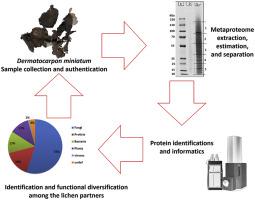当前位置:
X-MOL 学术
›
Fungal Biol.
›
论文详情
Our official English website, www.x-mol.net, welcomes your feedback! (Note: you will need to create a separate account there.)
Metaproteomics reveals the structural and functional diversity of Dermatocarpon miniatum (L.) W. Mann. microbiota
Fungal Biology ( IF 2.5 ) Pub Date : 2021-01-01 , DOI: 10.1016/j.funbio.2020.10.001 Junaid Ullah 1 , Zainab Khanum 2 , Ishtiaq Ahmad Khan 2 , Abdul Nasir Khalid 3 , Syed Ghulam Musharraf 4 , Arslan Ali 5
Fungal Biology ( IF 2.5 ) Pub Date : 2021-01-01 , DOI: 10.1016/j.funbio.2020.10.001 Junaid Ullah 1 , Zainab Khanum 2 , Ishtiaq Ahmad Khan 2 , Abdul Nasir Khalid 3 , Syed Ghulam Musharraf 4 , Arslan Ali 5
Affiliation

|
Metaproteomics is a strategy to understand the taxonomy, functionality and metabolic pathways of the microbial communities. The relationship among the symbiotic microbiota in the entire lichen thallus, Dermatocarpon miniatum, was evaluated using the metaproteomic approach. Proteomic profiling using one-dimensional SDS-PAGE followed by LC-MS/MS analysis resulted in a total of 138 identified proteins via Mascot search against UniRef100 and Swiss-Prot databases. In addition to the fungal and algal partners, D. miniatum proteome encompasses proteins from prokaryotes, which is a multifarious community mainly dominated by cyanobacteria and proteobacteria. While proteins assigned to fungus were the most abundant (55 %), followed by protists (16 %), bacterial (13 %), plant (11 %), and viral (1 %) origin, whereas 4 % remained undefined. Various proteins were assigned to the different lichen symbionts by using Gene Ontology (GO) terms, e.g. fungal proteins involved in the oxidation-reduction process, protein folding and glycolytic process, while protists and bacterial proteins were involved in photosynthetic electron transport in photosystem II (PS II), ATP synthesis coupled proton transport, and carbon fixation. The presence of bacterial communities extended the traditional concept of fungal-algal lichen symbiotic interaction.
更新日期:2021-01-01



























 京公网安备 11010802027423号
京公网安备 11010802027423号